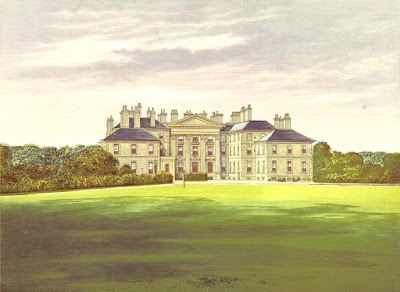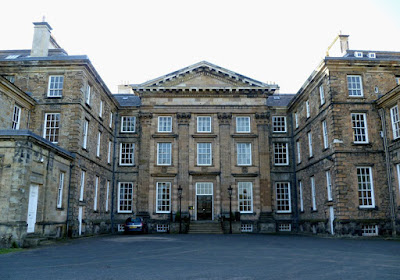 |
| King Charles I at the time of his trial in 1649, as painted by Edward Bower. [Source : Wikipedia] |
But we do not however need to dwell on the lengthy and well documented reasons why, as decreed by Oliver Cromwell's 'Rump Parliament', that King Charles I, and convicted on the charge of High Treason, bravely met his fate at the hands of the executioner. But the subsequent, and sometimes inconsistent, story of his secretive burial is not widely known and is worth relating.
The Execution of King Charles I at Whitehall, 1649
From a painting by Ernest Crofts, R.A
Source : Bibby's Annual 1909
(from my own collection)
|
The above painting recreates the grim winter morning scene on the 30th January 1649 after King Charles I had been led through the Banqueting Hall at Whitehall Palace and out through an opening made in a window onto the scaffold prior to his execution. The executioner and his assistant are ready and waiting at right with the execution block visible. Mr Herbert [Sir Thomas Herbert], the King's faithful servant and 'Groom of the Bedchamber', is shown holding his master's hat and cloak while supporting himself on the window sill, being in a state of distress and collapse. King Charles, at left, with perfect dignity and calmness, hands the blue ribbon of the Order of the Garter, which he had worn around his neck, to Bishop Juxon. Roundhead soldiers keep back the sullen and disapproving crowd. Thus has been immortalised a significant and pivotal event in British history.
 |
| King Charles I's Bible, believed given to Bishop Juxon just prior to his execution. [Source : TheBookofDays.com] |
Herbert writes that prior to his execution, King Charles I passed his Bible to Bishop Juxon to be passed onto his son who was then safely in exile in France; "His Majesty also delivered him his Bible, in the margin whereof he had, with his own hand, written many annotations and quotations, and charged him to give it to the Prince [the future King Charles II] so soon as he returned."
Being a bitterly cold day, Charles went to his execution wearing two heavy shirts so that he might not shiver in the cold and appear to be afraid. Prior to the actual execution, King Charles I "declared publicly that he died a Christian according to the profession of the Church of England."
 |
| King Charles I's Watch, given to Sir Thomas Herbert on the morning of his execution. [Source : TheBookofDays.com] |
Finally, with the King indicating that he was ready, the executioner carried out the fatal stroke. Click Here if you wish to read a full transcript of the King's final words prior to his execution.
The identity of the masked and disguised Executioner remains unclear, the official Executioner, Richard Brandon, at least initially, refused to carry out the task despite payment of £200 being offered. But an examination of the skull in 1813, clearly shows a clean strike from a steady hand. The British Parliamentary website claims that after the Restoration in 1660 The House of Lords ordered the return of the Death Warrant from Charles’ [unnamed] executioner, then being imprisoned in the Tower of London. But we know Richard Brandon himself died in June 1649, just five months after Charles.
 |
| A contemporary German print of the Execution of King Charles I [Source : Wikipedia] |
From this point there are at least two separate published accounts which I shall primarily refer to. The first narrative is dated 1721 and relies heavily on the earlier published memoirs, of Mr John Rushworth (died 1690), Clerk-Assistant to the Parliamentary House of Commons under Cromwell, and particularly that of the King's Groom of the Bedchamber, Sir Thomas Herbert (died 1682), written between 1678 and 1681.
The second narrative, written by Edward Hyde, Earl of Clarendon, prior to his death in 1674 and published in 1807, unfortunately varies somewhat. I shall however attempt to find some commonality in these accounts or note where the accounts markedly differ. Even in 1681 Mr Herbert refers to "misinformation" as to events.
 |
| Another representation of the execution of King Charles I. Painter unknown, c.1649. [Source : National Galleries of Scotland] |
We know from the 1721 and earlier accounts, that immediately after the execution "The corpse was put into a coffin, and the Bishop and Mr Herbert went with it to the Back-stairs to have it embalmed; after embalming, his head was sewed on, and the corpse was wrapt in lead, and the coffin covered with a velvet pall then removed to St. James's."
The condition of the body in 1813 confirms that it was speedily embalmed. We also know that the body was wrapped in cere-cloth [a waxed cloth used to cover the dead] and placed in a wooden coffin prior to being sealed in a plain leaden coffin. The velvet pall was noted lying over the coffin in 1813.
 |
| The head of King Charles I, having been re-stitched onto his body. From a contemporary painting. |
The 1807 narrative of Lord Clarendon conversely states that "His body was immediately carried into a room at Whitehall; where he was exposed for many days to the public view, that all men might know that he was not alive. And he was then embalmed, and put into a coffin, and so carried to St. James's [Palace]; where he likewise remained several days...". This account appears partly spurious.
We do however know from Herbert's memoirs that many wished to see the King's body whilst it lay in his chambers at St. James's Palace. He confirms that until the 7th February "it was exposed to public view", also that many would have given money "for locks of his hair" but these requests were refused by Mr Trapam, the King's Surgeon. Herbert also notes of the 'public viewing' that "but few had leave to enter and behold it".
 |
| Oliver Cromwell visiting the coffin of King Charles I, from a painting by Paul Delaroche, 1831 [Source : Wikipedia] |
Oliver Cromwell is also alleged to have visited Charles's coffin one night, sighing "Twas a cruel necessity!" as he did so. Neither narrative mentions this alleged event, being published as late as 1894.
The 1721 narrative informs us that the King's above-mentioned faithful servant, Mr Herbert and another Royal Courtier, Mr Anthony Mildmay, made all the initial burial arrangements. The King is not believed to have left any specific requests regarding his burial. Mr Herbert initially made application to Parliament to have His Majesty buried in the Chapel of King Henry VII at Westminster Abbey. This was refused as "his burying here would attract members of all sorts thither, to see where the King was buried; which, as the times were, was judged unsafe and inconvenient."
 |
| The Chapel of King Henry VII in Westminster Abbey, as painted by Canaletto, early 1750's. It had been intended that King Charles I would be interred here. [Source : Wikipedia] |
After discussions, Mr Herbert then made application to Parliament to bury His Majesty in the Royal Chapel of St George at Windsor, both in regard to his having been a member of the Most Noble Order of the Garter and that several other Kings were interred there. Approval was granted on the 6th February 1649.
The 1807 narrative notes that four of the late King's faithful Noblemen, being the Duke of Richmond, the Marquis of Hertford, and the Earls of Southampton and Lindsey also made application to "those who governed, 'that they might have leave to perform the last duty to their dead master, and to wait upon him to his grave.'"
This request was hesitantly granted, "that they should not attend the corpse out of town; since they resolved it should be privately carried to Windsor without pomp or noise, and then they should have timely notice, that, if they pleased, they might be at his interment." Furthermore, the cost was not to exceed £500.
The 1721 narrative later records these four Noblemen appearing unexpectedly at Windsor which indicates that they acted independently of Messrs. Herbert and Mildmay.
 |
| Sir Thomas Herbert [Source : Wikipedia Commons] |
The 1807 narrative claims that "...that it was committed to four of those servants who had been by them [those in authority] appointed to wait upon him during his imprisonment, that they should convey the body to Windsor..." Those four servants were Messrs Herbert, Mildmay, Preston and Joyner, along with "some others in mourning equipage".
The 1721 narrative describes the sombre scene as the cortège left St James's Palace on the night of the 7th February 1649; "...a hearse covered with black velvet, drawn by six horses covered with black cloth, in which were about a dozen gentleman, most of them being such that had waited upon his Majesty...". Four coaches followed, two also being covered with black cloth.
Click Here to read Part Two of this Blog which details the arrival at Windsor Castle and the further events that transpired.
Bibliography :
- "Athenae Oxonienses", Vol II, Woods, 1721
- "History of the Rebellion and Civil Wars in England", Vol III, Clarendon, 1807
- "Memoirs of the Last Two Years of then Reign of King Charles I", Sir Thomas Herbert, 1813
- "An Account of what Appeared on Opening the Coffin of King Charles The First", Sir Henry Halford, 1813


























